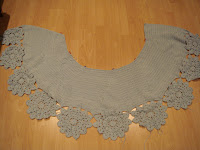 A few weeks ago Susan (of the Rainey Sisters) put out a request on behalf of Wrapped in Care for shawls. It seemed a good cause so when I found some lovely pale blue Rowan Cashcotton on sale at John Lewis - I scooped up two bags. Now all I needed was a pattern.
A few weeks ago Susan (of the Rainey Sisters) put out a request on behalf of Wrapped in Care for shawls. It seemed a good cause so when I found some lovely pale blue Rowan Cashcotton on sale at John Lewis - I scooped up two bags. Now all I needed was a pattern.I browsed a few gazillion online shawl patterns, but - nothing sang to me. I flipped through my books and magazines - and still nothing. Then someone somewhere posted a link to a new book by Kristin Omdahl called Wrapped in Crochet - and there it was (you'll have to flip through the preview to Maya). IN amongst many lovely lovely patterns, was the pattern I really wanted to make.
Yippee.
But the book isn't out until autumn.
Bummer.
From the little bit of the book preview I could read, Kristin was inspired by a shawl she seen in Italy, made of a simple double crochet body with and edging of large medallions. Her version is triangular and looks very elegant in a gold-y tone yarn.

I decided not to let a small detail like no book stop me. So I took out my very expensive designing tools and set about making these meticulous blueprints to work with.
Browsing through some old crochet books I found a pattern for coasters in White Lace Crochet (Ondori) (an out of print book from 1990) which crocheted in the dk weight yarn (rather than the teeny tiny cotton the pattern called for) and a few modifications would be perfect for the edging.
I decided on 10 medallions for the edging and these were pretty straightforward once I got going. I was feeling pretty confident at this point. Which as we all know means doom is just around the corner.
 I started the body of the shawl with the same hook I'd made the medallions in and after about 10 looooooooonnnnnngggggggg rows (3 full skeins of yarn!) (am I impressing on you how much work I'd done?) it was apparent that the tension was WAY OFF on the body. Despite lots of decrease per row - the body was still bigger than the edging! I couldn't kid myself - no amount of blocking was going to make this work.
I started the body of the shawl with the same hook I'd made the medallions in and after about 10 looooooooonnnnnngggggggg rows (3 full skeins of yarn!) (am I impressing on you how much work I'd done?) it was apparent that the tension was WAY OFF on the body. Despite lots of decrease per row - the body was still bigger than the edging! I couldn't kid myself - no amount of blocking was going to make this work.So I ripped it all out. Well, not all, just the 10 loooooooonnnnnggggg
 rows (3 full skeins). I kept the medallions. I started the body over with a much smaller hook and 10 looooooooonnnnnnngggggg rows later I was smiling. I could see the beginning of a semi-circle. Yippee!
rows (3 full skeins). I kept the medallions. I started the body over with a much smaller hook and 10 looooooooonnnnnnngggggg rows later I was smiling. I could see the beginning of a semi-circle. Yippee!As everyone knows, rows and rows of double crochet are very good for watching Jane Austen adaptations. I chose to crochet to Mansfield Park with Billie Piper playing Fanny. And, well, I'm not sure the film makers actually read the book.

Yesterday morning I finished the last double crochets, wove in the ends and then blocked the very large shawl on my bed.
The shawl is 72" across the top with a 36" drop and took 14 50gm skeins of Rowan Cashcotton.
I'd love to make another one with a silk yarn one day, as I think the drape would be amazing. I'm pleased with the finished shawl, and hope it provides some comfort to the recipient.












